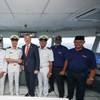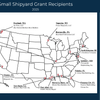Australia's ill-starred fleet of Collins class submarines could dive into action next year after a major refit, although they will end up slower than originally planned, the Royal Australian Navy (RAN) reported.
Rear Admiral Peter Briggs said the technical, design and manning problems that have dogged the $3.25 billion project were gradually being resolved.
The Navy plans to provide the government with the option of having two of the six new submarines - first conceived of 12 years ago - continuously deployed up to 2,500 nautical miles from base by December 2000. "That's a nice simple statement, but to achieve it you have to have all six submarines working to their full performance, so it's actually quite a demanding task," Briggs said.
Five of the submarines have either been commissioned or launched, and one has yet to be delivered. But none are at the degree of readiness to meet Australia's defense requirements.
Under the original project, the first submarine should have been fully ready for action more than three years ago.
An independent review of the project published earlier this year criticized the submarines for their poor design, out-of-date combat system, noisy engines, cracked propeller blades and poor periscope images - among other things.
The issue of engine vibration, crucial to a submarine's ability to remain undetected, was tackled by slowing the power plants down, although operating speed would also suffer, Briggs said. "We have had good results from a slower engine speed, with a significant reduction in vibration from the engine running at a slightly lower speed and we've now fitted that modification," he said.
Combat systems were also being upgraded and replaced as a matter of priority, but the latest version - Revision 2 - of combat software provided by U.S. aerospace group Boeing would not be installed for some time, Briggs said.
The RAN will submit a "roadmap" to the government on Sept. 30, specifying what additional funding it will need to bring the project, which has burst its original budget by a figure estimated by some at around $325 million, back on track. "I have a fair confidence that what I'm recommending is going to be picked up," Briggs said. The report will include a proposal that the newest vessels, Sheean and Dechaineux, be put on an upgrade "fast track" to meet the December 2000 deadline.
But manning the submarines could be a more difficult problem even than funding. Of the 679 crew needed to run the six-vessel fleet, Australia currently has no more than 259 fully trained.
"I consider that manpower will be a limitation for us for a couple of years. It's going to take time to overcome the deficit we have," Briggs said.
Sponsored Content
Safer Starts Here: Build Ships, Protect Crews

Featured videos

Meet the Volvo Penta IPS Electric (E)

Maritime Energy Transition: Cummins Focuses on Methanol

Efficient Maritime Operations Transcend Data; Intelligence is Key
Subscribe for
Maritime Reporter E-News
Maritime Reporter E-News is the maritime industry's largest circulation and most authoritative ENews Service, delivered to your Email five times per week









